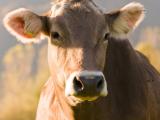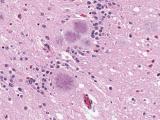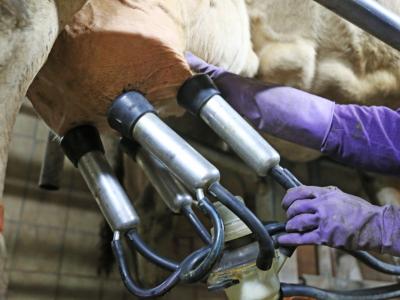Jun 29, 2006 (CIDRAP News) Current estimates of how many people could die of variant Creutzfeld-Jakob disease (vCJD) may be too low, because the disorder may have a prolonged incubation time in some people, according to a study of a related disease published in the Jun 24 issue of The Lancet.
Variant CJD is a prion disease linked to eating meat infected with bovine spongiform encephalopathy (BSE), or mad cow disease. The Lancet report deals with kuru, another human prion disorder, which arose from cannibalistic funerary practices among the Fore tribe in Papua, New Guinea.
The authors of the study, John Collinge of University College London and colleagues, report on some kuru victims in whom the disease incubation period was several decades. They suggest that the same could be true for vCJD, which implies that the cases seen since the disease emerged in the 1990s may be only a fraction of the ultimate toll.
Kuru occurred among the Fore until Australian territorial authorities outlawed ritual cannibalism in the late 1950s. Once the practice was banned, the number of cases of kuru declined sharply.
The authors speculated that current kuru cases might be used to assess the disorder's incubation time. By studying individuals who developed kuru long after cannibalism had been prohibited, the investigators sought to provide a better estimate of the BSE-like disease's incubation period.
The scientists identified 7 men and 4 women in the South Fore tribe who were born between 1933 and 1949 and fell ill with kuru between 1996 and 2004. All of the patients were born before cannibalism had been outlawed and had been exposed to the practice. Four female patients had died within 1 to 2 years after disease onset between the ages of 49 and 58 years. The age of onset among affected males was between 46 and 62.
DNA analysis of the prion protein gene (PRNP) from 10 of 11 patients showed that 8 of the patients were heterozygous at polymorphic codon 129, a pattern associated with extended incubation periods and resistance to prion diseases. This distribution pattern was not significantly different from that of 140 normal South Fore members who were used as a comparison group, however.
The analysis of disease onset dates revealed that the minimum estimated incubation period for kuru among these patients was between 34 and 41 years. The likely incubation times in men were between 39 and 56 years and could have been up to 7 years longer, according to the report. Kuru is thought to have an average incubation time of 12 years, based on data from more than 2,700 kuru cases occurring after 1957.
Cultural practices among the Fore dictate that boys be separated from their mothers at the age of 6 to 8 years and sent to live with the men of the tribe, according to the article. The boys were exposed to the same risk as men from that time onward. Because men did not participate in ritual cannibalism or eat brain, the most infectious tissue, this event provided a baseline estimate of the incubation period, according to the authors.
Other genes analyzed included those implicated in long incubation periods in human prion diseases. These genes' distribution was also not significantly different from frequencies among the healthy South Fore. The authors of the study acknowledge, however, that the number of affected patients represented a small sample size for comparisons.
Implications for vCJD and dissenting views
The study may have implications for individuals who have eaten BSE-infected beef and are at risk for vCJD. The disease's incubation period is unknown. After vCJD emerged in the United Kingdom in 1996, some experts estimated that more than 100,000 cases could eventually occur among the millions of people at risk. But only about 160 cases of vCJD have been detected in the UK to date, and the early estimates were sharply reduced.
The authors state that because of the genetic basis for vCJD susceptibility, the cases identified so far may represent people who are genetically predisposed to have the shortest incubation period. "Because of the powerful genetic effects on incubation period in laboratory animals, vCJD patients identified could represent a distinct genetic subpopulation that has an unusually short incubation period of BSE prions," they write.
The investigators suggest that the vCJD epidemic may be multiphasic and that recent estimates of its size, based on an assumption of uniform genetic susceptibility, could be substantial underestimations.
The authors also point out that animal studies show a prolongation of incubation time in cross-species transmission of spongiform encephalopathies. A human epidemic, they say, will be difficult to model accurately until modifier genes are identified and their frequencies in the population are known.
Not all experts agree with the expectation of many more cases of vCJD. A New York Times article describing the study quoted one prion expert, Dr David Westaway of the University of Toronto, as saying, "That's a provocative conclusion, but I am not sure it's totally plausible."
The Times also quoted several other dissenting experts, including Dr Richard T. Johnson, a Johns Hopkins University microbiologist; Dr Robert Klitzman, a Columbia University psychiatrist who wrote a book about kuru; and Dr Eugene O. Major, acting director of basic neuroscience at the National Institutes of Health. They observed that kuru is a human disease and that human-to-human transmission is more efficient than cross-species transmission such as cow-to-human, as occurs with vCJD.
Collinge J, Whitfield J, McKintosh E, et al. Kuru in the 21st centuryan acquired human prion disease with very long incubation periods. Lancet 2006 Jun 24;367(9528):2068-74 [Abstract]
See also:
Jun 12, 2006, CIDRAP News article "Study implies broader risk for vCJD in UK"
Aug 13, 2004, CIDRAP News article "Study implies many more vCJD cases may emerge in UK"


















